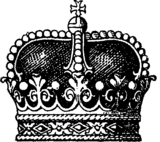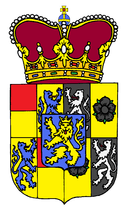Fürst


Fürst (German pronunciation: [ˈfʏʁst], female form Fürstin, plural Fürsten; from Old High German furisto "der Erste", English "the first", a translation of the Latin princeps) were, since the medieval period, members of the highest nobility who ruled over the Holy Roman Empire and later its former territories, below the ruling Kaiser (emperor) or König (king).[2] A Prince of the Holy Roman Empire was the reigning sovereign ruler, monarch, of an imperial state that held imperial immediacy in the boundaries of the Holy Roman Empire.[2] The territory ruled is referred to in German as a Fürstentum (principality),[3] the family dynasty referred to as a Fürstenhaus (princely house), and the (non-reigning) descendants of a Fürst are titled and referred to in German as Prinz (prince) or Prinzessin (princess).[4]
English uses the term prince for both concepts. Latin-based languages (French, Italian, Romanian, Spanish, Portuguese) also employ a single term, whereas Dutch as well as the Scandinavian and Slavic languages (Russian, Polish, Serbian, etc.) use separate terms similar to those used in German (see knyaz for the latter).
Since the Middle Ages, the German designation and title Fürst refers to:
- the highest members of the nobility who ruled over the Holy Roman Empire, below the ruling Kaiser (Emperor) or König (King)[2]
- members of the nobility above the rank of Graf (Count) but below Herzog (Duke)[2]
- a Ruler, Monarch[2]
Use of the title in German



The title Fürst (female form Fürstin, female plural Fürstinnen) is used for the heads of princely houses of German origin (in German a Fürstenhaus). From the Late Middle Ages it referred to any vassal of the Holy Roman Emperor ruling over an immediate estate. Unless he also holds a higher title, such as grand duke or king, he will be known either by the formula "Fürst von + [geographic origin of the dynasty]", or by the formula "Fürst zu + [name of the ruled territory]". These forms can be combined, as in "...von und zu Liechtenstein".
The rank of the title-holder is not determined by the title itself, but by his degree of sovereignty, the rank of his suzerain, or the age of the princely family (note the terms Uradel, Briefadel, altfürstliche, neufürstliche; and see German nobility). The Fürst (Prince) ranked below the Herzog (Duke) in the Holy Roman Empire's hierarchy, but princes did not necessarily rank below dukes in non-German parts of Europe. Likewise, the style usually associated with the title of Fürst in post-medieval Europe, Durchlaucht (translated as "Serene Highness"), was considered inferior to Hoheit ("Highness") in Germany, though not in France.
The present-day rulers of the principality of Liechtenstein bear the title of Fürst, and the title is also used in German when referring to the ruling princes of Monaco. The hereditary rulers of the one-time principalities of Bulgaria, Serbia, Montenegro, and Albania were also all referred to in German as Fürsten before they eventually assumed the title of "King" (König).
Other uses in German
Fürst is used more generally in German to refer to any ruler, such as a king, a duke, or a fürst in the broad sense (cf. Machiavelli's Il Principe). Before the 12th century, counts were also included in this group, in accordance with its usage in the Holy Roman Empire, and in some historical or ceremonial contexts, the term fürst can extend to any lord.
The descendants of a Fürst, when that title has not been restricted by patent or custom to male primogeniture, is distinguished in title from the head of the family by use of the prefix Prinz ("prince", from Latin: princeps; female Prinzessin).
A nobleman whose family is non-dynastic, i.e., has never reigned or been mediatised, may also be made a Fürst by a sovereign, in which case the grantee and his heirs are deemed titular or nominal princes, enjoying only honorary princely title without commensurate rank. In families thus elevated to princely title (usually as reward for military or political services) in or after the 18th century, the cadets often hold only the title of count (Graf), e.g. Bismarck, Hardenberg, Eulenberg), but in a few cases the title of Fürst was shared equally by all male-line descendants of the original grantee (e.g., the families of Wrede, Hohenberg, Urach).
Derived titles
Several titles were derived from the term Fürst:
- Reichsfürst (Prince of the Empire) was a ruling Prince whose territory was part of the Holy Roman Empire. He was entitled to a vote, either individually (Virilstimmen) or as a member of a voting unit (Curiatstimmen), in the Reichstag. Reichsfürst was also used generically for any ruler who cast his vote in either of the Reichstag's two upper chambers, the Electoral College (Kurfürstenrat) or the College of Princes (Fürstenrat): Their specific title might be King, Grand Duke, Duke, Margrave, Landgrave, Count Palatine (Pfalzgraf), Burgrave, Imperial Prince (Reichsfürst) or Imperial Count (Reichsgraf). Usually included in this group were the reichsständisch Personalisten, Imperial princes and counts whose small territories did not meet the Fürstenrat's criteria for voting membership as an Imperial estate (Reichsständ), but whose family's right to vote therein was recognised by the Emperor. Officially, a Prince of the Church (Kirchenfürst) who voted in the Electoral or Princely College, along with a handful of titular princes (nobles granted an honourary but hereditary title of prince by an Emperor who, however, were not reichsständisch, lacking a vote in the Fürstenrat) might also be referred to as Reichsfürsten.
- Kirchenfürst (Prince of the Church) was a hierarch who held an ecclesiastic fief and Imperial princely rank, such as Prince-Bishops, Prince-abbots, or Grand Masters of a Christian military order.
- Landesfürst (Prince of the Land) is a princely Head of state, i.e. not just a titular prince. A Land was a geo-political entity with (feudal) statehood, whether fully independent or not. The term is sometimes translated as in states bound together only in a personal union (e.g., the Electorate of Hanover and the United Kingdom of Great Britain and Ireland) their joint ruler reigns as a Landesfürst in each of the realms under different titles and constitutions, thus, e.g., the Habsburg emperors held a different regnal style in each of their Kronland ('crown land') realms.
- Kurfürst (Prince-Elector) was a Prince of the Holy Roman Empire with a vote in the election of the Holy Roman Emperor, as designated by the Golden Bull of 1356 or elevated to that status subsequently. Originally, only seven princes possessed that right, some secular, some ecclesiastic. This prerogative conferred on its holders rank inferior only to that of the Emperor, regardless of the specific title attached to each Elector's principality. Kur (earlier spelled Chur) is derived from kur/küren, "to choose". Properly an office of the Empire rather than a hereditary title, during the long de facto tenure of the Imperial throne held by the House of Habsburg, the Electorates were less distinguished from other Imperial princes by their right to choose an emperor than by the right to transmit the fief associated with the office to a single heir by primogeniture, originally unknown in Germany, rather than to divide lands among descendants in multiple appanages, allowing preservation of each Elector's territorial integrity and power.
- Großfürst (Grand Prince) was a rare title in German-speaking lands, and was used primarily to translate titles borne by rulers outside the Holy Roman Empire (e.g., Russia, Tuscany). In 1765 Empress Maria Theresa proclaimed the Hungarian province of Transylvania to be a "Grand Principality" (Großfürstentum Siebenbürgen), whereafter it became one of the titles of the Emperor of Austria in 1804.
- Fürstprimas (Prince primate) referred to the head of the member states of the Napoleonic Confederation of the Rhine established in 1806, then held by the Mainz archbishop Karl Theodor Anton Maria von Dalberg. Today it is a rarely used episcopal title: Upon the elevation of the Esztergom (Gran) archbishop, Christian August of Saxe-Zeitz, to a Prince of the Holy Roman Empire in 1714, his successors bear the title of a Prince primate (Hungarian: hercegprímás) up to today. The Archbishops of Salzburg still hold the title of Primas Germaniae though their diocese is located in Austria.
Origins and cognates
The word Fürst designates the head (the "first") of a ruling house, or the head of a branch of such a house. The "first" originates from ancient Germanic times, when the "first" was the leader in battle.
Various cognates of the word Fürst exist in other European languages (see extensive list under Prince), sometimes only used for a princely ruler. A derivative of the Latin Princeps (ironically, a Republican title in Roman law, which never formally recognized a monarchic style for the executive head of state but nominally maintained the Consuls as collegial Chief magistrates) is used for a genealogical prince in some languages (e.g., Dutch and Frisian, where a ruler is usually called vorst (Frisian: foarst), but a prince of the blood is always styled prins (Frisian: prins); and Icelandic where fursti is a ruler, and a blood prince is prins (in these languages no capital letters are used in writing titles, unless, of course, they occur as the first word of a sentence)), while in other languages only a Princeps-derived word is used for both irrespectively (e.g., English uses prince for both). In any case the original (German or other) term may also be used.
References
- 1 2 Siebmacher, Johann; Weber, Hilmar Hermann (1890). Siebmacher's Grosses und allgemeines Wappenbuch: in einer neuen. Einleitungsband. Abt. A, B. [Siebmacher's Coat of Arms Volumn: in a new introductory version ... Section A, B, Otto Titan von Hefner] (in German). Nürnberg: Otto Titan von Hefner.
- 1 2 3 4 5 Duden; Definition of the German title Fürst (in German).
- ↑ Duden; Definition of Fürstentum (in German).
- ↑ Duden; Definition of the German title Prinz (in German).
| Look up Fürst in Wiktionary, the free dictionary. |
Further reading
- German Empire (in German- use the English and French translated versions only with due caution)
- Danubian Monarchy Austria-Hungary (in German- use the English and French translated versions only with due caution)
- Westermann, Großer Atlas zur Weltgeschichte (in German)
- WorldStatesmen - here Germany (with specifics on the HREmpire); see also other present countries
- Etymology Online
